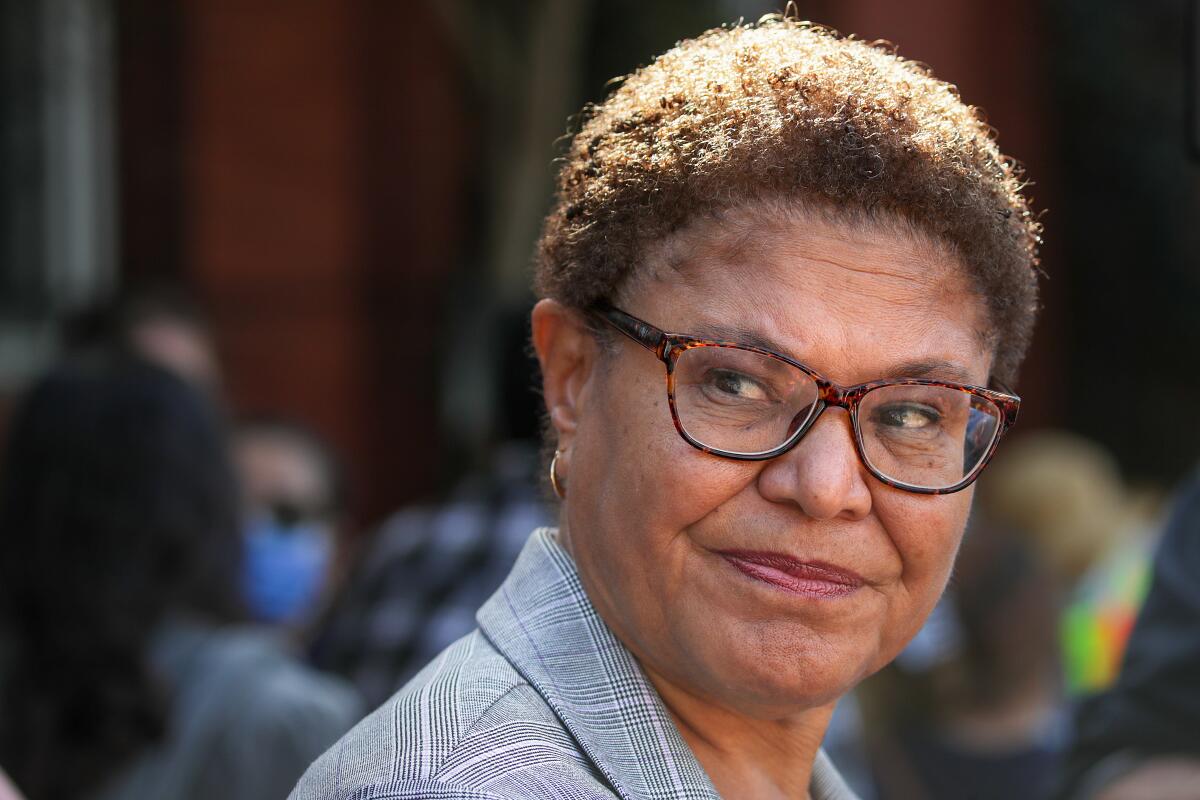Divided council gives modest boost to LAPD hiring, amid tensions with mayor
Months of tension between Los Angeles Mayor Karen Bass and members of the City Council burst into public view Friday when the council rebuffed the mayor’s request to significantly increase police hiring.
The face-off between the mayor and some council members has been brewing since the council voted in May as part of the city budget to reduce LAPD hiring to 240 officers this year — half of the 480 officers requested by Bass — in order to close a $1-billion budget shortfall and prevent layoffs of other city workers.
Then, when Bass signed the budget, she mentioned she had reached an agreement with Council President Marqueece Harris-Dawson to find additional money to restore police hiring. The duo said they would find the money within 90 days.
The 90 days came and went. Then another 90 came and went. All the while, the LAPD continued hiring.
As of this month, nearly halfway through the fiscal year, the LAPD has already brought on all 240 new hires accounted for in the budget. To continue hiring officers, the City Council would need to allocate more money.
Against that backdrop, Bass sent a letter to the council Wednesday, calling on them to fund up to 410 new hires over this fiscal year, which ends in July. Some council members balked, saying they feared the hiring would cause a continuing deficit, since the new police officers will be on the city payroll for decades to come.
Bass’ push was backed by Councilmember John Lee, who called on his colleagues to fund the 410 hires by peeling $4.4 million away from other parts of the city budget, including the Human Resources Benefits Fund, the Police Health and Welfare Fund and the Innovation Fund.
The cost of the extra hires would jump to $24 million next year, and it was not clear how the city would fund their salaries in coming years.

Karen Bass at a farmers market on Nov. 4, 2022.
(Irfan Khan / Los Angeles Times)
“Here we are, considering an unvetted funding proposal none of us saw until this morning,” said Councilmember Katy Yaroslavsky, who chairs the council’s Budget and Finance Committee.
Yaroslavsky has said she would support hiring the 410 new officers if funding is available. She said the Budget Committee has repeatedly reached out to the mayor and the council president to find funding solutions but did not receive a response until this week, right before the council goes on recess for the holidays.
Yaroslavsky introduced her own proposal Friday to hire one additional class of 40 police recruits in January for $1.7 million — bringing the number of police hires up to 280 this fiscal year. She also requested that the LAPD and the city administrative officer return in January with ways to pay for more police hiring that does not come from one-time sources.
The council passed Yaroslavsky’s plan in an 11 to 4 vote.
Harris-Dawson, who supported the mayor’s goal of 410 officers, said that tensions over police hiring date back a half century. He cited a 2003 dispute between then-Mayor James Hahn and then-Council President Alex Padilla, with the council voting to delay police hiring due to the city’s financial issues.
“What we’re going through today is consistent with how the city of L.A. runs,” he said.
Bass had hoped to keep the department from shrinking significantly this year. The LAPD is anticipating losing 552 officers to attrition. If no more officers are hired beyond the 240 already brought on, the department could fall to 8,386 officers, the lowest number since 1995.
“Stopping the hiring of new police officers will have drastic and lasting consequences for our city,” Bass wrote in her letter to the City Council.
The mayor cited the 2026 FIFA World Cup and the 2028 Olympics as reasons the city needs to grow its police force.
“We cannot knowingly and willingly increase the demands on our officers while reducing their workforce to the lowest levels in more than 20 years,” she said.
The city’s police union, the Los Angeles Police Protective League, supported Bass’ efforts to fund the 410 officers.
“Angelenos need this Council to understand that neighborhoods are clamoring for more police, not less, and it is time to end the political posturing and put their money where their mouths are and grow the force,” the union said in a statement Friday.
Times staff writers David Zahniser and Sandra McDonald contributed to this report.
